The GIGABYTE Z170X-Gaming G1 Review: Quad-SLI on Skylake, and now with Thunderbolt 3
by Ian Cutress on December 1, 2015 9:30 AM EST- Posted in
- Motherboards
- Gaming
- Intel
- Gigabyte
- PLX
- PLX8747
- Z170
- Thunderbolt 3
Gaming Performance 2015
Our 2015 gaming results are still relatively new, but the issue of FCLK settings might play a big role here. At launch, the default setting for the communication buffer between the CPU and PCIe stack was 800 MHz, even though Intel suggested 1000 MHz, but this was because of firmware limitations from Intel. Since then, there is firmware to enable 1000 MHz, and most motherboard manufacturers have this - but it is unclear if the motherboard will default to 1000 MHz and it might vary from BIOS version to BIOS version. As we test at default settings, our numbers are only ever snapshots in time, but it leads to some interesting differences in discrete GPU performance.
Alien: Isolation
If first person survival mixed with horror is your sort of thing, then Alien: Isolation, based off of the Alien franchise, should be an interesting title. Developed by The Creative Assembly and released in October 2014, Alien: Isolation has won numerous awards from Game Of The Year to several top 10s/25s and Best Horror titles, ratcheting up over a million sales by February 2015. Alien: Isolation uses a custom built engine which includes dynamic sound effects and should be fully multi-core enabled.
For low end graphics, we test at 720p with Ultra settings, whereas for mid and high range graphics we bump this up to 1080p, taking the average frame rate as our marker with a scripted version of the built-in benchmark.
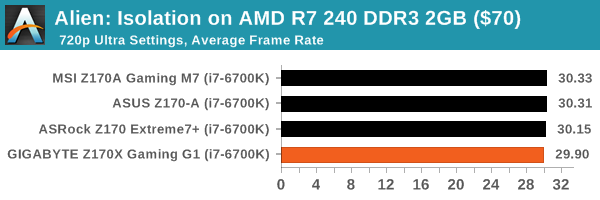
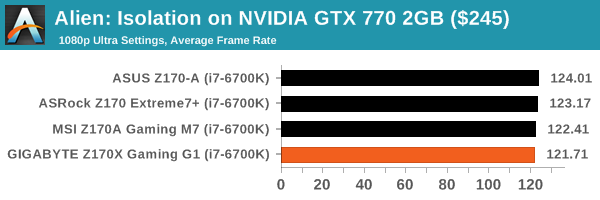
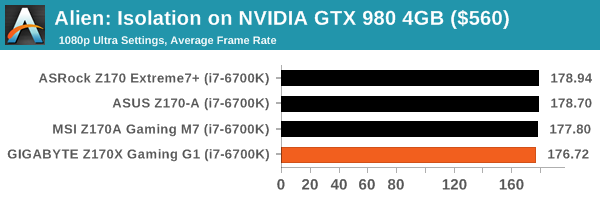
Total War: Attila
The Total War franchise moves on to Attila, another The Creative Assembly development, and is a stand-alone strategy title set in 395AD where the main story line lets the gamer take control of the leader of the Huns in order to conquer parts of the world. Graphically the game can render hundreds/thousands of units on screen at once, all with their individual actions and can put some of the big cards to task.
For low end graphics, we test at 720p with performance settings, recording the average frame rate. With mid and high range graphics, we test at 1080p with the quality setting. In both circumstances, unlimited video memory is enabled and the in-game scripted benchmark is used.

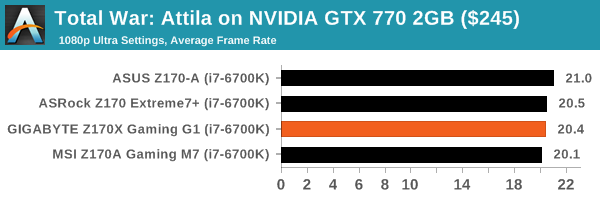
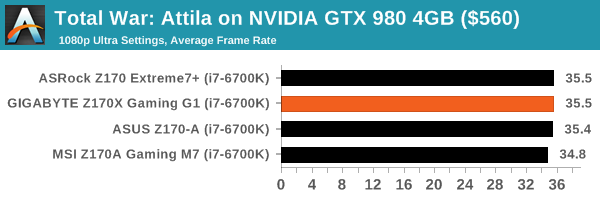
Grand Theft Auto V
The highly anticipated iteration of the Grand Theft Auto franchise finally hit the shelves on April 14th 2015, with both AMD and NVIDIA in tow to help optimize the title. GTA doesn’t provide graphical presets, but opens up the options to users and extends the boundaries by pushing even the hardest systems to the limit using Rockstar’s Advanced Game Engine. Whether the user is flying high in the mountains with long draw distances or dealing with assorted trash in the city, when cranked up to maximum it creates stunning visuals but hard work for both the CPU and the GPU.
For our test we have scripted a version of the in-game benchmark, relying only on the final part which combines a flight scene along with an in-city drive-by followed by a tanker explosion. For low end systems we test at 720p on the lowest settings, whereas mid and high end graphics play at 1080p with very high settings across the board. We record both the average frame rate and the percentage of frames under 60 FPS (16.6ms).
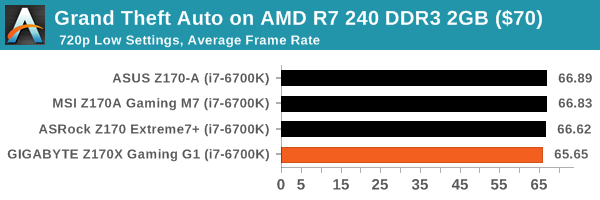
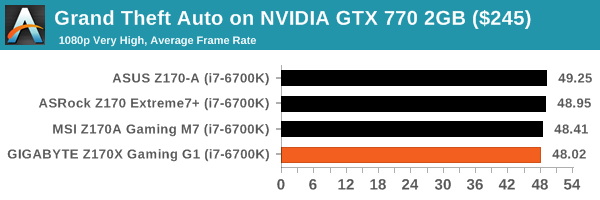
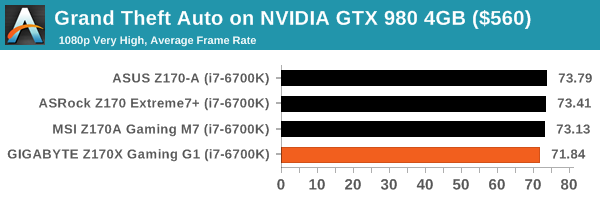
GRID: Autosport
No graphics tests are complete without some input from Codemasters and the EGO engine, which means for this round of testing we point towards GRID: Autosport, the next iteration in the GRID and racing genre. As with our previous racing testing, each update to the engine aims to add in effects, reflections, detail and realism, with Codemasters making ‘authenticity’ a main focal point for this version.
GRID’s benchmark mode is very flexible, and as a result we created a test race using a shortened version of the Red Bull Ring with twelve cars doing two laps. The car is focus starts last and is quite fast, but usually finishes second or third. For low end graphics we test at 1080p medium settings, whereas mid and high end graphics get the full 1080p maximum. Both the average and minimum frame rates are recorded.
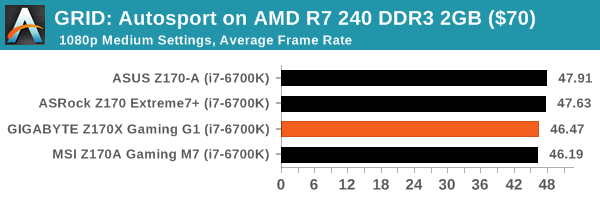

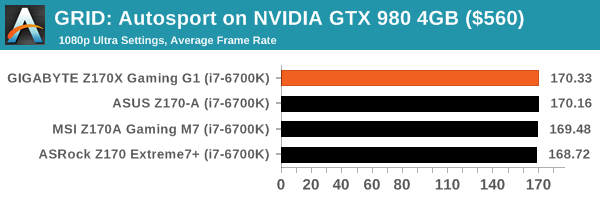
Middle-Earth: Shadows of Mordor
The final title in our testing is another battle of system performance with the open world action-adventure title, Shadows of Mordor. Produced by Monolith using the LithTech Jupiter EX engine and numerous detail add-ons, SoM goes for detail and complexity to a large extent, despite having to be cut down from the original plans. The main story itself was written by the same writer as Red Dead Redemption, and it received Zero Punctuation’s Game of The Year in 2014.
For testing purposes, SoM gives a dynamic screen resolution setting, allowing us to render at high resolutions that are then scaled down to the monitor. As a result, we get several tests using the in-game benchmark. For low end graphics we examine at 720p with low settings, whereas mid and high end graphics get 1080p Ultra. The top graphics test is also redone at 3840x2160, also with Ultra settings, and we also test two cards at 4K where possible.
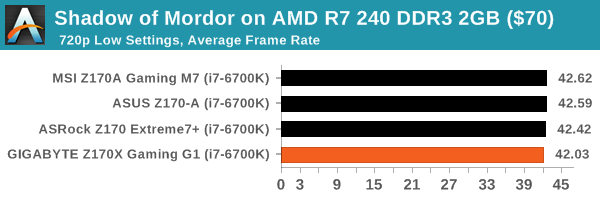
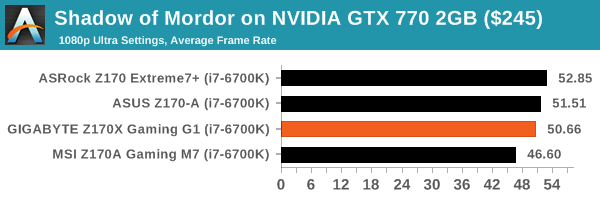
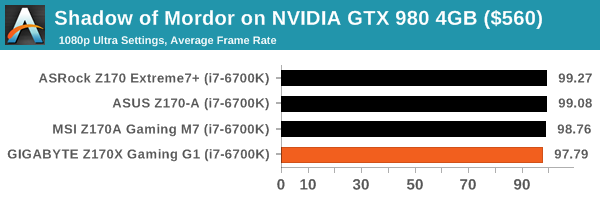
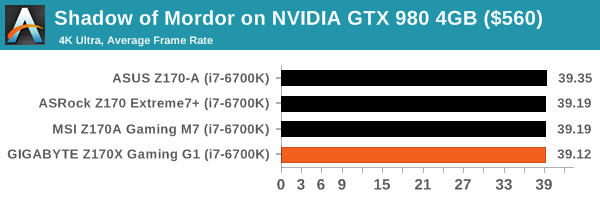















67 Comments
View All Comments
Questor - Monday, December 28, 2015 - link
I am not sure why so many motherboards are including the Killer LAN for the networking. The split second I read that, this motherboard fell to a $0.00 price point. I hate and by hate, I mean HATE Killer LAN networking solutions. One of my X99 boards and an ASRock 990FX have Killer LAN and neither implementation performs worth a fudge. The Intel solution on my other X99 (R5E), M5A99FX Pro R2.0 (B3) and the Realtek on my P67 board are faster, easier to deal with and never disconnect from anything or experience failure to load, latency issue, etc., unless my ISP itself is having problems. Killer has pushed my patients past the limit more than once. I am beginning to consider anything with Killer involved and reference to gamer or gaming to be like the horrid quality TN panels pushed off on the gaming public. A lesser class of product. Give me an Intel NIC and leave me in my heaven. I load the drivers and they just work; never have to mess with them again!__187__ - Wednesday, January 6, 2016 - link
first of all, u have enough lanes for quad sli because u have 16 lanes for the graphics card coming from the cpu and another 20 coming from the chipset via dmi. Makes atotal of 36lanes u could split up.Whats normally not working out are multiplexing chips, if it splits up without errors u left with the performance decrease. So at quad sli u left with 4 lanes for everything else, m2ssds/usb3.0chips/killer nics etc etc
That brings us to the weak spot of this test. The only thing whats different from other boards is entirely not tested. Pls make this thing full with gpus and m2 ssds etc and test if this multiplexing works out. Should be possible tou to get 4 identical gpus, im sure gigabyte got some lying around. If not ask asus if they help u prove that the new gigabyte board is crap. Im sure u got 4 gtx 980ti tomorrow.
Keep in mind that this 500buck board loses every gaming benchmark against a 100buck asus board with one third the phases.
Next joke is the connection of the vrm coolers for water. What is this a 6mm outer diameter pipe? Thx for leaving 10% of my waterflow. Make it 2mm next time.
Is it prefilled or is it an empty "heat"pipe on aircooling?
Next problem is that a dual sli of 980ti's gets limited from a 5820 or 5930 sometimes.
So how much ln2 do i need gigabyte for not bottlenecking a quad sli?
Total bs. And nobody should put together a 960 or whatever quad sli, not even a normal sli if its not really needed. The poor scaling(not a major thing at dual but at triple and quad) is a nightmare, then u got micro stuttering, driver issues and heat/space problems.
If needed ahigh end card dual sli but everything else is wasted money. Wait till next year when pascal and polaris are coming.
Even if the money doesnst care, i would rather go in the next pub and spend the 400bucks there than throwing it away like this
__187__ - Wednesday, January 6, 2016 - link
and it has also worse sound quality, boot time, usb3.1 performance and dpc latency.This must be a joke for 5 times the price.
Also a joke is that at doesnt test the oc ability of this oc board.
__187__ - Wednesday, January 6, 2016 - link
and its recommended by anand so its the third joke in a row.Not tested properly and poor performance in combination with high power consumption gets u an recommended. omg
__187__ - Wednesday, January 6, 2016 - link
But the truth is, gigabyte dont uses the 36 lanes that are possibel, instead they are telling just sthg. as u can see in the link gigabyte brings to us the wonder of splitting up 16lanes into 4 times 8, get u some of that. So they leave the most of the 20 chipset lanes untouched but u only have troubles with ur gpus not the m2 ssds ;)http://techreport.com/review/29346/gigabyte-z170x-...
some wild switching and multiplexing going on there.
Buyers pls dont expect that this hell of a build will run fine anytime soon.
__187__ - Wednesday, January 6, 2016 - link
instead of that ur m2 ssds will throttle because they are crammed(not sure if its the right word) under the gpus, lol__187__ - Wednesday, January 6, 2016 - link
but no, m2 ssds already throttle even if no gpu is installed. gj gigabyte.the likes are: fan header amounts, lighted shield if its dimmable, better socket, full black pcb, dual bios and for a few upgradeable audio.
Next time f.e. better make the wlan module socketed to a chinch or coaxial spdif interface card instead of a second killer nic and put 2 vrm coolers in the box. both together doesnt work out very
well. or just 3 adjustable 40-60mm fans side by side angled upwards pulling to the rear fan of manycases. then just half the phases all on left side connected with good tim and there u go with ur better thermal solution. Then customer can remove the fan package and screw on an adapter for water cooling if needed. fins go over to passive mode. Or let the chassis intrusion switch switch on some white leds on the mobo for checkups.
Just in case someone of gb reads this and u guys wanted to do 3 killer nics on next mobo just ask us what would be nice, im sure u get plenty of ideas from there.